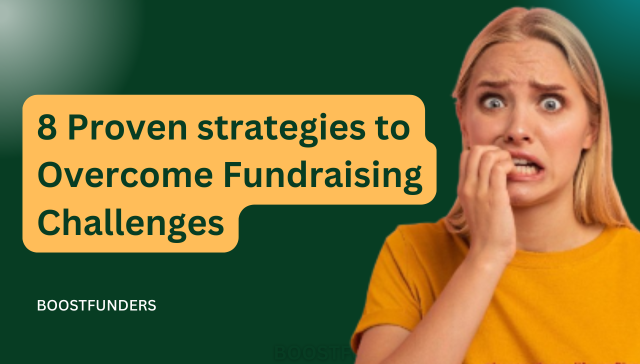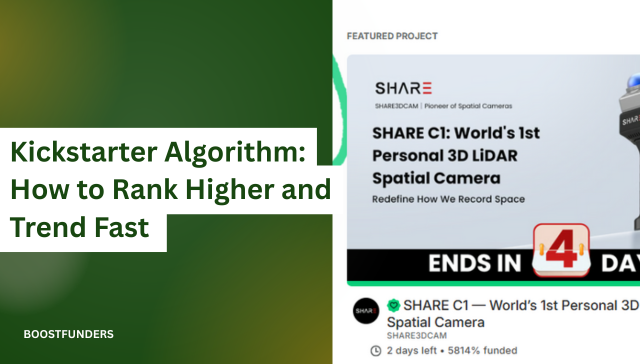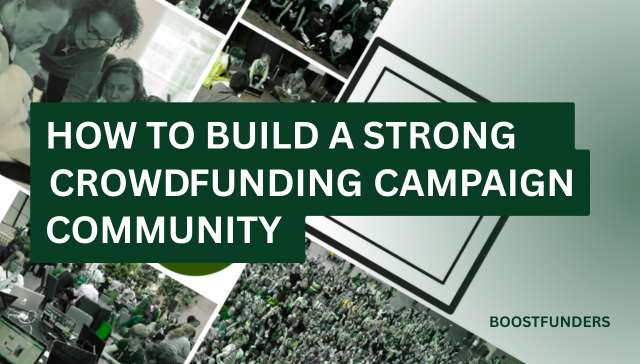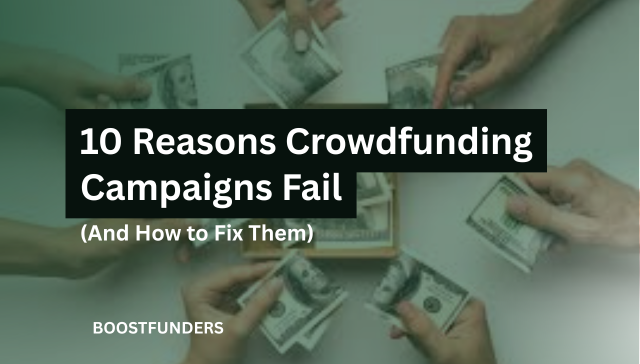8 Proven Strategies to Overcome Fundraising Challenges
 I hope you find this blog helpful as you plan your crowdfunding journey. If you’d like personalized support or expertguidance to help make your campaign a success, click here
I hope you find this blog helpful as you plan your crowdfunding journey. If you’d like personalized support or expertguidance to help make your campaign a success, click here
Author: Adebayo Ogungbemile | Founder of Boostfunders
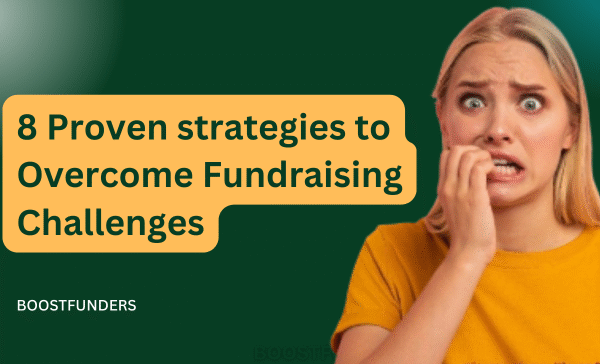
Table of Contents
1. Identify and Understand Your Audience
2. Craft a Compelling Story
3. Leverage Social Media Strategies and Email Marketing Campaigns
4. Set Realistic and Achievable Goals
5. Build Trust and Transparency with backers
6. Offer Meaningful Rewards
7. Prepare for Platform Fees, Logistics, and Regulations
8. Sustain Momentum Throughout the Campaign
9. Conclusion
10. FAQ
Imagine having a brilliant idea for a project but lacking the financial resources to bring it to life. This is the reality for many Individuals, entrepreneurs, and innovators. With crowdfunding and online fundraising growing more popular, opportunities abound—but so do the challenges. In this blog, I’m going to show you how to deal with those fundraising challenges and raise funds successfully for your creative project or ideas.
- Identify and Understand Your Audience
The first major challenge faced by many individuals, entrepreneurs, or campaigners nowadays is the lack of ability to narrow down their targeted audience and understand their audience. It’s not just about identifying people who are interested in your project; it’s about identifying those who are willing and able to support it financially.
How to deal with it.
To understand your audience, you’ll need to research your audience and begin by answering a series of questions like Who are my customers? How can I effectively reach them? What price are they willing to pay for these offerings? Lastly, who are the competitors they might be considering?
To solve the question above, you can use social media insight tools, email analytics to segment your audience, and tools like Mailchimp for the email segment. Look at demographic data, interests, and behaviors to tailor your messaging effectively.

Tip: Create detailed audience personas that reflect your ideal backers. Customize your communication to speak directly to their values, needs, and desires.

Example: A creative artist targeting environmentally conscious backers might focus on how their project contributes to sustainability, using social media channels like Facebook, TikTok, and others where eco-friendly advocates are most active.
2. Craft a Compelling Story
People find it difficult to tell a story that resonates with the kind of action they want people to take or the kind of belief they want people to have about what they are selling to the public.
People don’t just invest in ideas—they invest in stories. A compelling narrative can turn a casual viewer into a passionate supporter. It has the power to evoke emotions, inspire action, and create a lasting connection between the Project and the audience. Through a compelling story, fundraisers can effectively communicate their mission, vision, and impact, ultimately motivating people to support their creative efforts.
How to deal with it
a. Highlight your journey, your mission, and the impact your project will have.
Begin by sharing the story behind your project. Explain why you started, the challenges you’ve faced, and what drives your passion. Let your audience understand the purpose behind your mission, and show them how their contributions will directly support meaningful change.
People want to back projects that they believe will make a difference. Show them how their involvement can create a ripple effect—whether it’s contributing to a creative revolution, supporting sustainability, or fostering innovation in your industry.
Tip: Break your story down into digestible sections—why you started, what you’re currently working on, and where you want to go. Each section should be backed up in a way that will make the journey relatable.
b. Authenticity is the key.
Show the real passion and effort behind your work to build a deeper emotional connection with your audience. When people see your real passion and dedication, they are more likely to trust and support your cause. Being genuine about your challenges and how you’ve overcome them helps build a deeper emotional connection with your audience.
Don’t be afraid to show vulnerability. Share the struggles you’ve encountered in getting your project off the ground. Let people see that you’re not just asking for money, but are fully committed to putting in the hard work to bring your vision to life.
Tip: Include behind-the-scenes photos and videos that showcase the effort you’re putting into the project. Authentic, unpolished moments often resonate more with an audience than overly produced content.
c. Crowdfunding Storytelling in a Template or Imagery Format.
While written text in a document can be effective, presenting your fundraising story in a more visually engaging format can inspire your audience and keep them engaged. Using templates or imagery-based formats allows you to combine compelling visuals with storytelling, making the narrative more dynamic and immersive.

A visual storyboard is a great way to structure your narrative using a combination of images and concise text. Think of it as a comic strip that walks potential backers through your journey step by step. Each frame can represent a key part of your story: the problem, the inspiration, the solution, and the impact.
3. Leverage Social Media Strategies and Email marketing campaigns.
Social media strategies are one of the means of spreading the word about your campaign. Whether your campaign is at the stage of pre-launch or already launched, it is crucial to have well-developed social media marketing strategies to reach out to your targeted audience who are likely to support or back your crowdfunding campaign. It allows you to build awareness, engage potential backers, and create a sense of community around your project. Utilize platforms like Instagram, Twitter, Facebook, TikTok, and LinkedIn to regularly update followers on your progress. Boostfunders can help to tailor the best social media strategies that work for your creative ideas and generate high return on investment (ROI) on Ads spent from Facebook and Instagram ads.
How to deal with it
When it comes to social media strategy, the most recommended method of marketing your crowdfunding campaign is to engage or join targeted communities or groups on platforms like Facebook and Linkedin and start sharing your ideas with these members inside the communities. You can do this once or twice per day.
Another effective means of spreading the word and driving backers or supporters to your campaign is by running Ads on social media platforms such as TikTok, Meta (Facebook & Instagram), X (formerly Twitter), and Linkedin Ads. With this, you can also get boostfunders to help you create a creative ad set and copy while also helping you narrow down your target audience through segmentation, ensuring you reach the right people at the right time.
Creating social media pages for your project is also another method to spread the word about your campaign and get the project or idea close to people who may have an interest or get inspired and support you financially. You can create social pages for your creative ideas even before you start raising funds and make sure you are consistent in posting about your project on every social page you create.
Email marketing strategies
Email marketing remains one of the best marketing strategies for reaching out to your targeted audience. Unlike social media, which can often be crowded or filtered by algorithms, emails land directly in your audience’s inbox, providing a more personal and direct channel for communication. If done correctly, email marketing can build trust, maintain engagement, and drive backers to support your campaign.
Some crowdfunding platforms like Kickstarter and Indiegogo offer a pre-launch campaign that allows fundraisers or campaigners to collect the list of backers or followers before the campaign goes live. This is to enable the owner to reach out to the audience when the campaign goes live, both platforms provide tools to help you build an email list before the time the campaign goes live to ensure the campaign gets the initial traction it needs to succeed right from the start.
1. Build a Targeted Email List
2. Segment Your Audience for Personalized Emails
3. Craft Engaging and Concise Subject Lines
4. Tell Your Story and Highlight Progress
5. Create a Clear Call to Action (CTA)
6. Time Your Emails Effectively
7. Use Follow-Up and Thank You Emails
4. Set Realistic and Achievable Goals
Setting a funding goal that’s too high can lead to disappointment, while setting it too low might leave you without the necessary funds to bring your project to life.
How to deal with it
Start by creating a detailed budget that covers every aspect of your project, from production to marketing. Then, look at similar campaigns for benchmarks and set achievable goals.
Setting Small Goals That Lead to Greater Success
Many successful campaigns start with small goals and end up raising far more than anticipated. By setting a smaller, achievable target, fundraisers often build early momentum, which can lead to a snowball effect. Early backers see that the goal is within reach, which boosts confidence and encourages more contributions. As the campaign gains traction, stretch goals can be introduced to enhance the project and bring in even more funding.
For instance, someone might initially set a $12,000 goal for a creative project to cover basic production costs. However, if backers see the project gaining popularity, additional contributions often flow in, and the project can easily surpass its original goal, sometimes even doubling or tripling the target amount.
This strategy helps avoid the risk of falling short while allowing the possibility of greater success than initially planned just like this campaign.
5. Build Trust and Transparency with backers.
Trust and Transparency are the foundation of any successful crowdfunding campaign and a crucial factor in deciding whether to contribute to your campaign.
Fostering an atmosphere of trust and maintaining transparency, will create a solid basis for those backers to turn to potential returning customers.
How to deal with it
Provide weekly Updates
Regular updates can go a long way in building credibility, and reassuring backers that their contributions are in good hands.
Thanks to platforms like Kickstarter, Indiegogo, Wefunder, and others who have provided the campaigner or fundraiser access to built-in tools to keep updating their supporters or backers directly on the platform they are using for fundraising.
These features make it easy for fundraisers to share progress, milestones, or any important changes with their audience.
You can keep engaging your backers using videos or blog posts through the crowdfunding platform or social media posts on your different social media platforms.

6. Offer Meaningful Rewards
Offering rewards is a great way to encourage support for your creative project, but poorly planned rewards can lead to unexpected costs that eat into the funds raised. Some fundraisers choose not to offer rewards at all and this makes the majority of a reward-based crowdfunding campaign fail.
Except if you are raising funds for a cause that might not require giving out a reward to your supporters and that is why they are called “Donors” under charity or cause fundraising. These are the set of people who give willingly just because they are emotionally connected to the cause, without expecting anything in return.
How to deal with it
Offer a copy of what you are raising funds for.
Rewards vary from project to project but often include a copy of what is being produced(game copy, smart belt, book, digital copy, etc.). Rewards that feel thoughtful and exclusive will attract more supporters (visits to the set, a private cooking class).
When creating rewards for your supporters, it’s important to go beyond just offering random items. The rewards should be closely related to your campaign and offer something exciting that motivates people to pledge their support. Thoughtful, relevant rewards can make a big difference in attracting backers to your project.

If you don’t know the type of reward you can offer, you can take a look at Kickstarter reward ideas here. https://www.kickstarter.com/blog/need-some-reward-ideas-here-are-96-of-them?ref=faq_creator_rewards .
In addition, you need to understand some prohibited items that you cannot offer as a reward either on Kickstarter, Indiegogo, Wefunder, or others. To know this, you can navigate through each platform and see some of the prohibited items but most especially majority of the crowdfunding platforms like Kickstarter did not support the following items as a reward;
- Any item claiming to diagnose, cure, treat, or prevent an illness or condition
- Contests, coupons, gambling, and raffles
- Energy food and drinks
- Live animals
- Offering alcohol as a reward
- Pornographic material
- Drugs, nicotine, tobacco e.t.c
- As part of a reward, you can also offer add-on perk
Add-ons are optional rewards that allow backers to choose additional items that aren’t included in their selected reward tier. You can offer add-ons that complement the main reward, like a movie poster, a gam,e expansion pack e.t.c

Lastly, carefully plan your reward tiers and understand the logistics involved in fulfillment. Calculate shipping costs, production times, and any other related expenses before setting your reward levels. This foresight can prevent financial headaches down the line.
7. Prepare for Platform Fees, Logistics, and Regulations
Crowdfunding platforms often take a percentage of the funds you raise, and reward fulfillment can involve costs like shipping and production. The cost of shipping may vary depending on the location and the shipping method. On the other hand the rules and regulations of each crowdfunding platform, as a fundraiser, you must understand the rules and regulations of the platform you want to use and ensure the type of campaign is allowed on the platform to avoid being rejected.
How to deal with it
Be sure to account for these in your budget to avoid surprises. Carefully plan your reward tiers and understand the logistics involved in fulfillment. Calculate shipping costs, production times, and any other related expenses before setting your reward levels. This foresight can prevent financial headaches down the line. If you are trying to use Kickstarter for your fundraising, then you can make use of their funding calculator here
Creators or fundraisers that are trying to use Kickstarter for their campaign should budget for (Kickstarter’s 5% fee, and payment processor’s roughly 5% fee) while Indiegogo platform fees are also 5%.


Example: A game project might carefully calculate international shipping costs for backers outside the main geographic region to avoid overspending on logistics.

8. Sustain Momentum Throughout the Campaign
sustaining momentum throughout a campaign can be difficult and requires careful planning and execution. Many campaigns start strong but lose steam halfway through, Keeping your audience engaged and maintaining momentum is crucial for success.
Regular updates and fresh content help maintain excitement throughout the campaign as it helps build relationships with them as well as encourages them to participate in the conversation. This can be done through social media posts, newsletters, events, or other ways or through providing updates from the crowdfunding platform you are using as discussed in No5.
Tip: Introduce stretch goals or limited-time rewards to encourage ongoing contributions. Keep your audience updated on milestones, and celebrate every success, no matter how small.
Example: A game development company might introduce a new in-game feature as a stretch goal or offer an exclusive character design for backers who contribute within a certain time frame.
Conclusion
Fundraising campaigns remain the best way of getting your creative projects funded. It may come with its fair share of challenges, but by applying these effective strategies, you can significantly increase your chances of success.
If you are new to crowdfunding, you can seek expert help to implement these strategies successfully or take your time to go through the steps one after the other from identifying your audience, telling a compelling story, mastering social media and email marketing strategies, and maintaining trust, you’ll set yourself up for a winning campaign. Start applying them today, and watch your fundraising campaign soar!
Recent Comments
Categories
- Business (2)
- Crowdfunding Strategy (7)
- Equity Crowdfunding Tips & Strategy (3)
- Fashion (2)
- LifeStyle (1)
- Movies (1)
- Restaurant (1)
- Technology (1)
FAQs
Some of the most common challenges of crowdfunding include identifying and reaching the right audience, standing out in the competitive market, setting realistic goals, building trust and transparency within the community, tailored marketing strategies, reward fulfillment, and maintaining momentum throughout the campaign.
Regular updates and fresh content help maintain excitement throughout the campaign as it helps build relationships with them as well as encourages them to participate in the conversation. This can be done through social media posts, newsletters, events, or other ways or through providing updates from the crowdfunding platform you are using. Introduce stretch goals or limited-time rewards to encourage ongoing contributions.
Storytelling helps create an emotional connection between you and your potential backers. By sharing the “why” behind your project. A compelling narrative can turn a casual visitor into a passionate supporter. It has the power to evoke emotions, inspire action, and create a lasting connection between the Project and the audience.
Start by creating a detailed budget that covers all project expenses. Then, look at similar successful campaigns for benchmarks and set smaller, achievable milestones that lead up to your larger goal.
Your rewards should be meaningful, appealing to your audience, and aligned with your project (Offer a copy of what you are raising funds for). Rewards vary from project to project but often include a copy of what is being produced(game copy, smart belt, book, digital copy, etc.). Also, make the shipping cost for each reward known to every backer on your campaign page.
To pick a crowdfunding platform for your project, start by understanding the category of fundraising that your campaign falls into whether it’s reward-based crowdfunding, charity, or equity crowdfunding. Once you’ve determined your category, research the top two platforms within that space and check which one aligns with your project, the size, and engagement of their community, and how well the platform fits with your niche. If you can solve this, then you can now pick the platform that suits your needs.
Social media strategies are one of the means of spreading word about your campaign. Whether your campaign is at the stage of pre-launch or already launched, it is crucial to have well-developed social media marketing strategies to reach out to your targeted audience who are likely to support or back your crowdfunding campaign.
Utilize platforms like Instagram, Twitter, Facebook, TikTok, and LinkedIn to run paid ads so as to reach a wide targeted audience based on your demographics.
In addition, consider setting up automated email marketing campaigns with a newsletter to keep your backers or supporters engaged.
Other strategies you can implement include Press Release, Google Ads, Forum marketing, Forum Ads, commenting, and much more.

